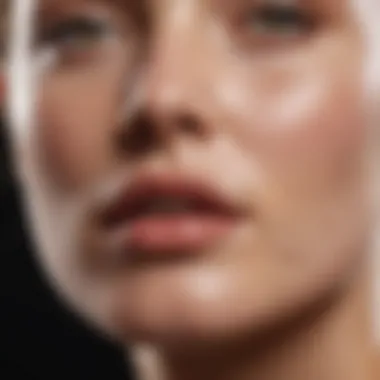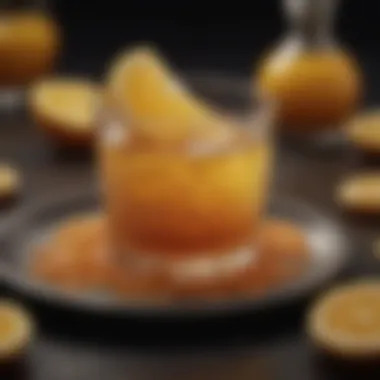The Comprehensive Guide to Sugaring Paste Techniques


Intro
In the evolving world of beauty and personal care, professional sugaring paste stands out as a preferred hair removal method for both professionals and individuals. This guide exposes the nuances of sugaring paste—from its formulation and application techniques to its benefits and growing significance in the realm of hair removal options. The aim here is to demystify this practice, highlighting not just why it is gaining traction but also how it compares to conventional waxing methods.
Various factors contribute to the success of sugaring paste. It’s derived from simple ingredients—sugar, water, and lemon, making it more natural compared to many commercial waxes. The method is celebrated for being less painful, offering a gentler alternative that can often lead to smoother skin with fewer side effects. In this guide, readers will learn proper techniques for application and discover insights to enhance client satisfaction. Additionally, misconceptions surrounding this practice will be addressed. This comprehensive examination of sugaring will illuminate its place in contemporary beauty trends, equipping readers with the knowledge needed to excel in their sugaring endeavors.
Understanding Sugaring Paste
Sugaring paste is gaining prominence in the realm of hair removal techniques. It offers a different approach compared to traditional methods like waxing. Knowing the basics of sugaring is essential for both beauty professionals and clients. This section illuminates key aspects such as what sugaring paste is and how it differs from waxing.
Definition and Composition
Sugaring paste is a natural hair removal substance made primarily from sugar, water, and often lemon juice. This mixture creates a thick, gel-like consistency ideal for removing hair effectively. The primary ingredients, sugar, and water, are combined and heated to dissolve the sugar. The addition of lemon juice or citric acid, if included, serves as a preservative and helps maintain the paste's texture.
The simplicity of the formulation is significant. It means that sugaring paste is less likely to cause irritation, an important consideration for those with sensitive skin. Furthermore, that makes it a more eco-friendly option compared to conventional waxing products that often contain synthetic ingredients. The transparency in composition of sugaring paste is appealing for consumers who prioritize natural skincare.
Difference Between Sugaring and Waxing
The fundamental difference between sugaring and waxing lies in their application methods and the materials used.
- Material Composition: Sugaring paste is almost entirely natural, while many waxes contain synthetic components like paraffin and resins.
- Temperature: Sugaring paste is generally applied at body temperature, posing less risk of burns. In contrast, wax must be heated to high temperatures, increasing the chance of discomfort for the client.
- Direction of Hair Removal: When sugaring, the paste is applied against the hair growth direction and removed in the same direction. This technique can minimize hair breakage and reduce pain levels. Waxing, on the other hand, requires removal against the hair growth direction, which can potentially lead to ingrown hairs and increased discomfort.
Sugaring not only eliminates hair but also can exfoliate the skin, making it a dual-purpose treatment.
Understanding these differences can help clients make an informed decision when choosing a hair removal method. Sugaring paste's innate properties and application techniques set it apart, possibly leading to a more comfortable experience compared to traditional waxing.
The Ingredients of Professional Sugaring Paste
The formulation of professional sugaring paste is crucial to understanding its effectiveness and safety for hair removal. Knowing the specific ingredients can help professionals make informed choices when applying sugaring techniques. The simplicity of the ingredient list, predominantly comprising natural substances, contributes to its appeal. This section delves into the key components that make up professional sugaring paste, emphasizing their unique qualities and benefits.
Natural Elements: Sugar and Water
At the core of all sugaring pastes are sugar and water. The sugar used is often a combination of granulated sugar and molasses, providing a sticky yet pliable paste. This sticky property allows the paste to bond effectively with hair without adhering too much to the skin, reducing discomfort during removal. Water is also essential. It acts as a solvent, helping to dissolve the sugar and allowing for a smooth application.
The naturalness of these elements is a strong selling point. Unlike chemical depilatories that can irritate the skin, sugar and water are less likely to cause adverse reactions. This makes sugaring suitable for a wider range of skin types. Moreover, the process of sugaring is often less painful than traditional waxing, largely due to the natural affinity of sugar for the hair, not the skin.
The Role of Citric Acid
Citric acid is another important ingredient in many professional sugaring pastes. It is commonly derived from citrus fruits and serves multiple purposes. First, it acts as a natural preservative, extending the shelf life of the paste. Second, citric acid helps to enhance the paste's consistency, ensuring that it remains pliable and easy to work with at various temperatures.
Additionally, citric acid provides minor exfoliating effects, removing dead skin cells while the paste is being used. This property can lead to smoother skin post-treatment. Understanding the dual role of citric acid in sugaring paste can clarify its benefits. It is not just an additive, but a key component that improves both efficacy and skin health during the hair removal process.
Investigating Additives and Essential Oils
While the primary components of sugaring paste are sugar, water, and citric acid, some variations include additives such as essential oils. Essential oils can enhance user experience by providing pleasant scents and potential therapeutic benefits. For instance, lavender essential oil can have calming effects, while tea tree oil is known for its antibacterial properties.
However, the inclusion of additives should be approached with caution. Prospective clients may have sensitivities or allergies to certain essential oils. It is essential for beauty professionals to be aware of their clients' skin types and preferences before using flavored pastes.
"The use of natural ingredients in sugaring paste not only benefits the skin but also appeals to clients who prioritize eco-friendly beauty products."


Application Techniques for Sugaring
The application techniques used in sugaring are critical to achieving optimal results. Correct methods enhance efficacy, minimize discomfort, and can even influence the longevity of hair removal. Getting these techniques right is paramount for both the professional and the client, making this section key to understanding how to successfully implement sugaring as a preferred hair removal method.
Preparation and Skin Care
Before initiating the sugaring process, proper preparation and skin care are essential. This includes cleansing the skin thoroughly to remove oils, dirt, and any previous products that could hinder adhesion. Using a gentle exfoliation can help as well, to remove dead skin cells and prepare the hair follicles.
- Cleansing the Skin: Use a mild soap or a skin cleanser suitable for sensitive skin. This should be rinsed off completely.
- Exfoliation: This can be done 24 to 48 hours prior to sugaring to enhance results without risking irritation.
- Drying the Skin: Once cleansed, ensure the skin is completely dry. Moisture can have a negative effect on the sugaring paste’s ability to effectively adhere to the hair.
Choosing the Right Temperature
Temperature plays a crucial role in the application of sugaring paste. The paste must be warm enough to spread easily but not so hot that it causes burns. Maintaining the right temperature ensures that the paste can effectively grab the hair, making the removal process smoother and less painful.
- Ideal Temperature: The range should be between 30°C to 40°C (86°F to 104°F). This range provides sufficient pliability.
- Testing Temperature: Always perform a patch test on a small area of skin before applying to larger areas. This prevents potential burns.
- Storage: Store the paste in a controlled environment, as temperature fluctuations can impact its consistency and performance.
Hands-On vs. Method with a Spatula
There are two main methods for applying sugaring paste: the hands-on technique and using a spatula. Each method has its benefits, and individual preference often dictates which is suitable.
- Hands-On Method: This technique involves using your fingers to apply the paste. It allows for precise control.
- Spatula Method: Here, a spatula is used to apply the paste. This method is more common in professional settings.
- Advantages: It provides a more intimate approach, allowing the esthetician to feel the skin and adjust pressure as needed.
- Disadvantages: This method requires proper hygiene. Care should be taken to ensure clean hands to avoid introducing bacteria.
- Advantages: It is more hygienic and less messy. It can also cover larger areas quicker.
- Disadvantages: It may not provide the same tactile feedback as the hands-on method, possibly making it less intuitive for some.
Benefits of Using Sugaring Paste
The use of professional sugaring paste offers numerous advantages worth considering for anyone involved in hair removal methods. These benefits extend beyond mere efficacy; they encompass skin health, environmental considerations, and economic factors as well. Understanding these elements is essential for beauty professionals and enthusiasts who seek to provide or experience superior hair removal solutions.
Skin Benefits: Less Irritation
One of the primary advantages of sugaring paste is its gentle approach to hair removal. Unlike traditional waxing, which typically uses hot wax that can lead to significant skin irritation, sugaring paste is applied at body temperature. This minimizes the risk of burns or excessive discomfort.
Furthermore, sugaring paste is formulated using natural ingredients, primarily sugar and water. This composition is less likely to provoke adverse reactions and is suitable for various skin types, including sensitive skin. Many users report fewer incidents of redness and inflammation post-treatment.
Additionally, the sugaring method removes hair in the direction of growth, reducing the risk of ingrown hairs and associated complications. This directional removal contributes to a smoother skin surface without the trauma that can occur from waxing.
Eco-Friendly Aspects
Sugaring paste stands out for its environmentally friendly profile. The ingredients are predominantly natural, which means they have lower chances of causing harm to the ecosystem compared to the synthetic additives found in many commercial waxing products. The biodegradable nature of the sugar in sugaring paste further supports sustainability efforts.
Moreover, the process of sugaring typically generates less waste. Most sugaring sessions do not rely on disposable materials like strips, as the paste can be used repeatedly during application. This reduces the overall impact on the environment.
In a growing industry focused on eco-conscious practices, sugaring paste aligns with the values of many consumers seeking sustainable beauty options.
Affordability and Accessibility
Another compelling benefit of sugaring paste is its cost-effectiveness. The main ingredients—sugar, water, and, sometimes, citric acid—are inexpensive and widely available. Professional treatments using sugaring paste tend to be more affordable than those relying on more expensive waxing products.
Additionally, the ease of preparation allows for do-it-yourself applications. Many understand how to make their own sugaring paste at home with minimal effort and cost. This accessibility empowers individuals who want to take charge of their hair removal practices without overspending on salon services.


Considering these factors, professional sugaring paste allows for a better balance between quality and cost. Its skin-friendly nature, eco-conscious formulation, and affordability make it an appealing choice for many.
"Sugaring paste offers a blend of benefits that appeal to both skin health and environmental sustainability, presenting a compelling case for its use in hair removal."
The various advantages of sugaring paste make it not only a practical choice but also a conscientious one as beauty trends continue to evolve.
Identifying Potential Misconceptions
Understanding the misconceptions around sugaring paste is vital for both practitioners and clients. These misconceptions can affect decisions about hair removal methods. Clarity can lead to more informed choices and improve client satisfaction. Addressing these potential misunderstandings also fosters trust and enhances the professionalism of sugaring services.
Is Sugaring Painful?
One common belief is that sugaring is painful. This arises from the general discomfort associated with hair removal methods. In reality, many individuals report that sugaring is less painful than waxing. This is primarily due to the technique used. Sugaring removes hair in the direction of growth, which can lessen discomfort. The formulation itself, being natural, may be gentler on the skin compared to wax, which often contains synthetic ingredients. While sensitivity varies from person to person, proper application and technique can greatly enhance comfort levels.
The Myth of All Hair Types
Another widely held belief is that sugaring can effectively remove hair from any type or texture. While sugaring works well for many hair types, it may not be as effective for very coarse or thick hair. The sugar paste may struggle to grip the hair well, making the process less effective. Additionally, hair length plays an important role; effective sugaring typically requires hair to be a certain length for proper removal. Therefore, it’s important for both practitioners and clients to understand the limits of sugaring and tailor their expectations accordingly.
Knowing these misconceptions can guide individuals toward better experiences with sugaring. It opens avenues for education, ensuring clients have realistic expectations and receive the best possible care.
The Evolution of Sugaring in the Beauty Industry
The landscape of hair removal has undergone significant changes over the decades. Sugaring, a technique that dates back to ancient Egypt, has seen a resurgence in popularity, highlighting its relevance in the realm of contemporary beauty treatments. This section examines both the historical roots and current innovations surrounding sugaring, providing a thorough understanding of its evolution within the beauty industry.
Historical Context and Cultural Origins
Sugaring has a rich history, often associated with various cultures. Historically, the practice can be traced back to ancient Egyptian civilization. It is believed that Cleopatra herself utilized sugar paste for her hair removal needs. The primary ingredients—sugar, lemon juice, and water—were accessible and effective for maintaining smooth skin in a time when beauty standards were already revered. Sugaring was not limited to Egypt; similar methods were also found in Middle Eastern countries and parts of Europe.
Over the years, the tradition of sugaring faded in some regions, with waxing and other hair removal techniques taking precedence. However, the resurgence of interest in more natural beauty products rekindled the focus on sugaring. This historical context is imperative as it shows the longevity and adaptability of the method across different cultures.
Current Trends and Innovations
In today’s beauty market, sugaring has adapted to meet the needs of modern consumers. The trend is not just about returning to roots but also about innovating practices to enhance effectiveness and accessibility. Many professionals are now utilizing advanced formulations for sugaring pastes, incorporating organic ingredients and essential oils to cater to sensitive skin and different hair types.
The integration of technology has also played a role in the evolution. For instance, industry professionals are now using thermometers to ensure the perfect temperature for applying sugaring paste. This precision enhances the overall experience for clients and minimizes discomfort, setting a new standard in the hair removal industry.
Sugaring services are increasingly offered in beauty salons and spas, reflecting a shift towards natural and holistic beauty treatments.
Moreover, educational programs for beauty professionals have emerged, focusing specifically on sugaring techniques. This emphasis on training ensures better results and higher client satisfaction rates. As a result, the sugaring method is not only seen as a traditional practice but also as an evolving art form within aesthetic treatments, combining past wisdom with modern needs.
In summary, the evolution of sugaring in the beauty industry highlights its historical significance and contemporary relevance. By embracing both its origins and innovations, sugaring stands as a prominent choice for many beauty enthusiasts today.
Best Practices for Professionals
In the realm of beauty services, exceptional outcomes are forged through diligence and adherence to specific practices. When it comes to professional sugaring, understanding and applying best practices is crucial. Not only does it ensure a superior experience for clients, but it also enhances the therapist's reputation for quality work. Best practices transcend mere technique; they encompass every interaction with the client from initial consultation to post-treatment follow-up.
Hygiene and Safety Protocols
Hygiene is paramount in any beauty treatment, and sugaring is no exception. Maintaining a clean workspace significantly minimizes the risk of infections and offers reassurance to clients.


First and foremost, practitioners should always wash their hands before starting any treatment. This simple act prevents the transfer of bacteria. Moreover, using disposable gloves can fortify this process further, especially when handling the sugaring paste. It is also critical to keep all tools sanitized and not to reuse any applicators unless they are properly sterilized.
Practitioners should create a hygiene checklist, which could include:
- Cleaning the treatment area before and after each client.
- Disinfecting equipment thoroughly after use.
- Ensuring that any linens used during treatment are clean and fresh.
Implementing these protocols not only safeguards client health but also engenders trust. Clients will feel cared for, knowing that the practitioner prioritizes their safety.
"Safety isn’t just about compliance. It's about fostering an environment where clients feel comfortable and valued."
Tailoring Services to Client Needs
Every client who walks through the door may have different expectations, individual skin sensitivities, or varying hair types. Therefore, personalizing the sugaring experience is vital. Listening to the client's specific needs ensures optimal results.
During the initial consultation, practitioners must engage with their clients. Understanding any allergies, prior experiences with hair removal, skin conditions, and even lifestyle factors can influence the choice of sugaring paste and technique used. This approach places the client at the forefront of the service.
Furthermore, adapting the treatment technique based on observed reactions during the procedure can also lead to better satisfaction. Educating clients about the process, what to expect, and any aftercare required fosters a collaborative atmosphere.
In summary, best practices for professionals in sugaring not only enhance the overall experience but also lay the groundwork for strong client relationships. Clients are not just participants; they are partners in the care process, and recognizing this can transform routine appointments into meaningful interactions.
Client Aftercare: Ensuring Satisfaction
After a sugaring treatment, client aftercare plays a vital role in ensuring satisfaction and the best possible results. The right aftercare can help maintain smooth skin and minimize any potential drawbacks following the hair removal process. Educating clients about aftercare is essential to foster trust and encourage repeat visits. Understanding these practices enhances the overall sugaring experience long after the treatment has concluded.
Post-Sugaring Skin Care Routine
Following a sugaring session, the skin requires special attention to promote healing and prevent issues. Clients should follow a few detailed steps in their skin care routine:
- Keep the Area Clean: Directly after sugaring, the treated area should remain clean. Clients should avoid touching their skin with unwashed hands.
- Moisturize Gently: Applying a gentle, alcohol-free moisturizer can help to soothe the skin. Ingredients like aloe vera or calendula are often beneficial for calming irritation.
- Avoid Heat and Sweat: For at least 24 hours post-treatment, clients should avoid hot baths, saunas, or intense workouts. Heat can aggravate the skin and lead to irritation.
- Exfoliate Lightly: After a few days, clients may begin a gentle exfoliation routine. This helps prevent ingrown hairs. A soft scrub or exfoliating cloth is advisable, but it should be done delicately.
- Stay Hydrated: Hydration is crucial for skin health. Drinking plenty of water helps the skin recover and remain supple.
These steps are crucial for ensuring skin recovery and helping to maintain the results achieved through sugaring.
Recognizing Adverse Reactions
Despite its many benefits, it's important to be aware of the potential for adverse reactions after sugaring. Clients should be informed about the signs to look for:
- Redness or Swelling: While some redness is normal after sugaring, it should subside within a few hours. Persistent redness may indicate a reaction.
- Itching or Burning Sensation: If clients experience intense itching or a burning sensation, it may signal that their skin is irritated or reacting to the paste.
- Rashes or Hives: Any skin abnormalities such as rashes or hives require attention. Clients should contact their practitioner immediately if they notice these symptoms.
- Infection Symptoms: If a client's skin begins to swell significantly or they notice an increase in warmth in the treated area, these could be signs of infection and should be treated by a medical professional.
Clients should always stay in touch with their beauty professionals regarding aftercare. Quick recognition and response to adverse reactions can help prevent more serious issues. Regular follow-up communication reinforces client trust and enhances long-term satisfaction.
"Effective aftercare is crucial for ensuring the best results from sugaring treatments. Not only does it enhance the experience, but it also supports the skin's health."
Finale: The Future of Sugaring Paste
The future of sugaring paste within the beauty industry holds significant promise. As trends continue to shift towards holistic and natural beauty treatments, sugaring stands poised to capture growing interest. Its reputation for being gentle on the skin, combined with its environmentally friendly ingredients, positions it well against traditional waxing methods.
Emerging Technologies and Practices
Innovation in sugaring practices is already underway. New formulations are being developed that enhance the effectiveness of sugaring paste. For example, technology is aiding in the development of warming devices that ensure perfect paste consistency for various skin types and hair textures. These advancements can cater to a wider audience, increasing the appeal of sugaring as an option in professional services.
Additionally, online platforms and apps now allow professionals to share techniques and methodologies, fostering a community that promotes best practices. Enhanced training programs are emerging, focusing on the science of sugar and the art of application. This collective effort not only increases proficiency among practitioners but also elevates the overall experience for clients.
"As beauty aficionados increasingly seek gentle and effective treatments, sugaring stands to redefine the hair removal landscape."
Final Thoughts on Professional Sugaring
As beauty professionals incorporate these innovations, they must also emphasize client education. Understanding the benefits and methodologies behind sugaring helps in establishing trust and satisfaction. Overall, sugaring is not merely a passing trend; it is a method that is aligning itself with contemporary values and practices. Professionals should therefore be prepared to embrace these changes while advocating for this effective hair removal technique.







